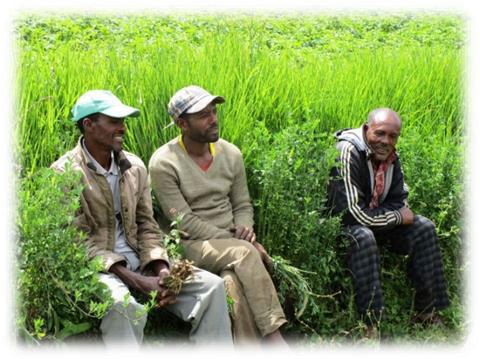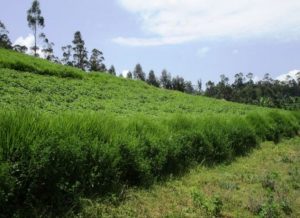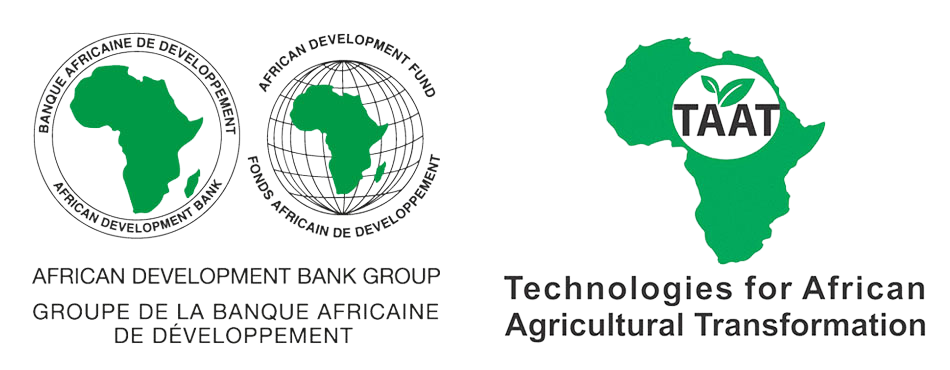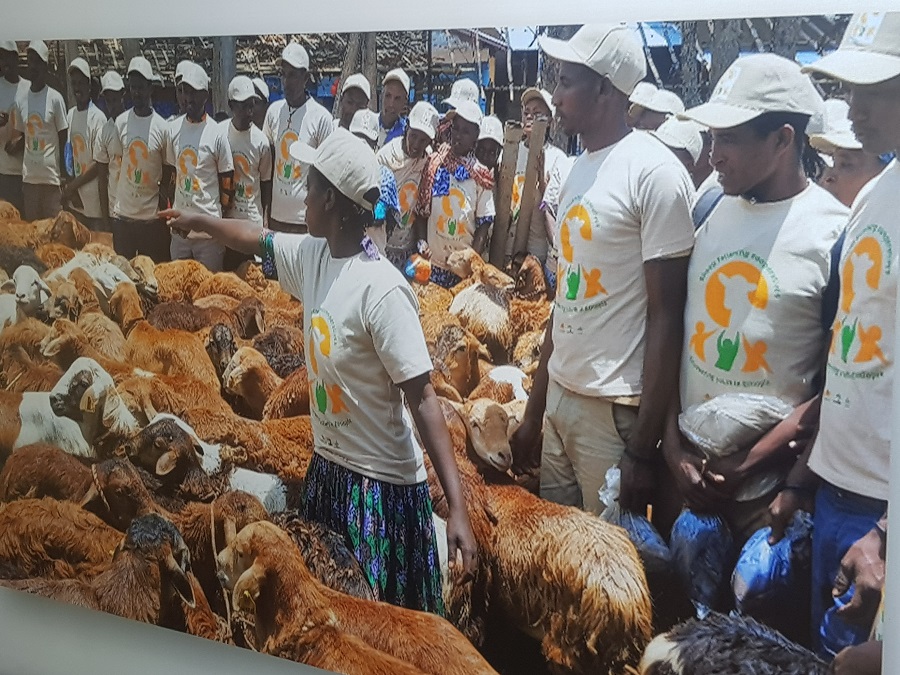How TAAT is deploying Feed Resources and Sheep Fattening Technologies to meet Ethiopia’s Livestock needs
This story highlights the importance of leveraging. The TAAT project in its infancy could never report a story like this without leveraging the TAAT project implementation with existing projects.
The TAAT Small livestock compact collaborated with Inter-Aide, an international NGO to strengthen the work of growing fodder to meet livestock feed requirement, soil conservation and food security among highland farmers in Ethiopia.
The story of these two neighbors shows that combining soil & water conservation and fodder production may lead to rapid and significant changes at farm level, by addressing through a single innovation, the acute shortage of fodder for livestock and the severe problem of erosion in these mountainous landscapes.
But the way to bring these changes is not that simple. There is an important social work to be conducted beforehand, with several constraints that need to be tackled.
First there was the problem of open grazing that discourages any investment in fodder production. The integration of fodder resource may only work if the whole community succeeds to define and apply rules to control open grazing, and to switch to cut and carry or zero-grazing practices.
To assure this, the project worked with the Iddir, a traditional community group that holds tremendous influence because it has a strong legitimacy from the community.
The Iddir, was used to galvanize the community to make and enforce ban on open grazing in the TAAT-Inter-Aide project areas. The need to deal with the problem of erosion comprehensively, by considering the whole sub-watersheds is another challenge.
This is associated with the critical issue of poor access to planting materials.
To overcome the latter, the livestock compact embarked on the use of farm-based backyard nursery. This was instrumental in increasing the capacity to multiply the fodder grass species starting from a few clumps.
These changes are the precursors that paved the way to provide the solutions to two major constraints faced by the families: the issue of the land fertility and the lack of diversified fodder for the livestock.
The control of animal grazing made it possible gradually to diversify the fodder resources, and also to introduce green manure cropping during the dry season, when parts of the lands are laid bare without any cover crop. It also contributes to better utilization of wheat or other cereals’ straws that were hitherto left in the field to be pastured by other animals.
A third benefit was the opportunity to encourage the integration of rich protein-rich drought tolerant n fodder hedges, such as tree Lucerne or Sesbania sesban, as additional fodder resources for livestock.

Ato Tesfay and his family live in the Kebele of Suticho 3 in the district (Woreda) of Doyo Gena. His 0.5 ha farm corresponds to the average surface of farms found in this area of Southern Ethiopia.
It is located in a steep slope of the mountain. Ato Tesfay explains that erosion control was his main concern, as well as the depletion of feeding sources for his animals. “I have decided to intercrop the grass fodder grown on anti-erosive structures with alfalfa.
This association is very interesting for animal feeding”. He also developed vetch, another fodder specie, for fodder and green manure. Integrated with land conservation, the development of permanent fodder resources in the farm had a considerable impact on the economy of the family, as shown by the elements of answer provided below.
For instance, late last year, Ato Tesfay bought an ox at the price of 7000 ETB (~250 USD), for fattening. After using this ox to plough the family land, he sold it in July 2018 at the price of 13.000 ETB. He then bought another new ox in August at 9.000 ETB, also for fattening, that he sold 4 months after at the price of 13.500 ETB.
This sole operation of animal fattening generated a gross profit of 10.500 ETB (~380 USD, 230 net profit), for the family. This is equivalent to national average of three and half months wages of around $65/month, or 5 months factory workers wages at USD 45.00/month.
The TAAT – Inter-Aide project is building the resilience of families like Ato Tesfay to adopt proven livestock technologies like fodder production and feed resource utilization to address the problem of feed shortage in the dry season, increase family income and protect the environment at the same time.
On her side, Ato Tesfay’s wife, Wazero Abanesh, is producing and selling dairy products: she is processing butter and cheese that she sells 3 times a week on the local market.
The production varies throughout the year but on average, she is getting about 1,000 ETB/week (~38 USD), thanks to the milk by-products. In the dry season, the quantity of milk usually decreases but it is compensated by the market price increase. In the rainy season, it is the opposite. Ato Tesfay is now extending alfalfa in his farm, mainly by cuttings.

Tesfaye’s neighbor, Ato Tessema, also started to collaborate with TAAT – Inter Aide Project. For him, the main concern was to conserve the land and preserve soil fertility. Access to fodder in the dry season was also a severe issue for the family.
After having constructed 170 m of soil bunds planted with grass to stabilize the anti-erosive structures, Ato Tessema tested other solutions:
“For the last 2 years, I have been testing the use of green manure to improve the fertility of the soil”. During the Belg season (dry season), part of his land is let for fallow.
Farmers from highland areas have indeed no alternative than cropping Irish Potatoes during the dry season. So, only part of his farm is used during this season.
In 2018, the project suggested to him to test improved fallow by using Vetch and Lupin as cover crops. He decided to focus on Vetch, planted the seeds in March and chopped the biomass at the beginning of June in order to incorporate it in the soil before ploughing it 3 weeks after.
He observed “a very positive effect on wheat production following the green manure. I kept some seeds apart in order to use them for seeds’ production, so I can continue to use green manure the next year”.
He therefore allocated a small plot for this purpose. After harvesting the seeds from this plot, he decided to plant “Portuguese cabbage”. That was when he noted the surprising effect of mixed fodder-cabbage production. As some left seeds fell on the ground, vetch germinated inside his cabbage and, in the absence of any adverse visible reaction, “I decided to let the vetch grow.
Looking at the adjacent plot, with cabbage only, I felt that it is a very good association”. This combination provides several benefits: soil cover and therefore decreasing weeding needs, providing additional source of fodder, up to 30% improved cabbage yields due to nitrogen fixing by the legume fodder.
This amounts to double harvest according to Ato Tessema.
In 2018, thanks to his own Vetch seeds production, he extended the surface with green manure and also dedicated some plots for Vetch whose leaves will be used for fodder.
This year, he will decrease the use of urea in his wheat plot that follows vetch by 1/3rd . At ~75 USD/50kg bag, Ato, will be saving nearly 2,000 ETB on urea fertilizer/ha of land planted to potatoes alone. He hopes to gain an additional benefit of nearly in fodder biomass harvest.

Ato Tessema is also proud of his first hedge of tree Lucerne (Pictured right, Photo credit – Inter-Aide 2018):
“It is providing an additional source of well-appreciated fodder!” He is now extending his hedge and is currently on the process of multiplying additional seedlings to be transplanted.
TAAT Livestock Feed, Forages, and the Sheep fattening Technologies: The Big picture:
Since inception, the TAAT small Livestock compact has engaged partners to deliver on the TAAT Feed and Forages for access to improved feeding to support the small ruminant fattening technology.
In Mali and Ethiopia, five delivery partners have been identified to deliver different components of the feed technology. It is important to note that the forages technology does not stand in isolation. It links to the Small ruminant fattening activities.



